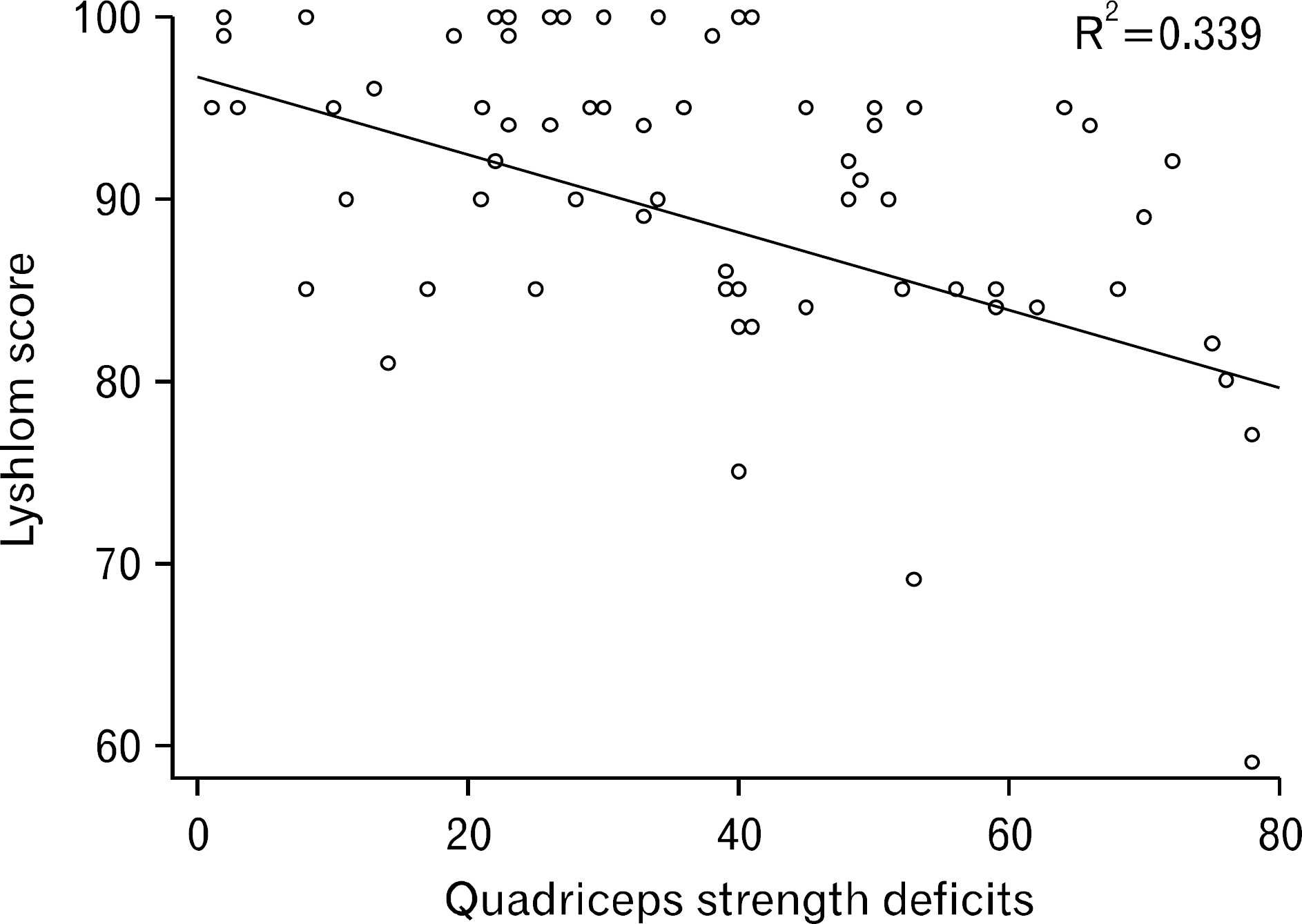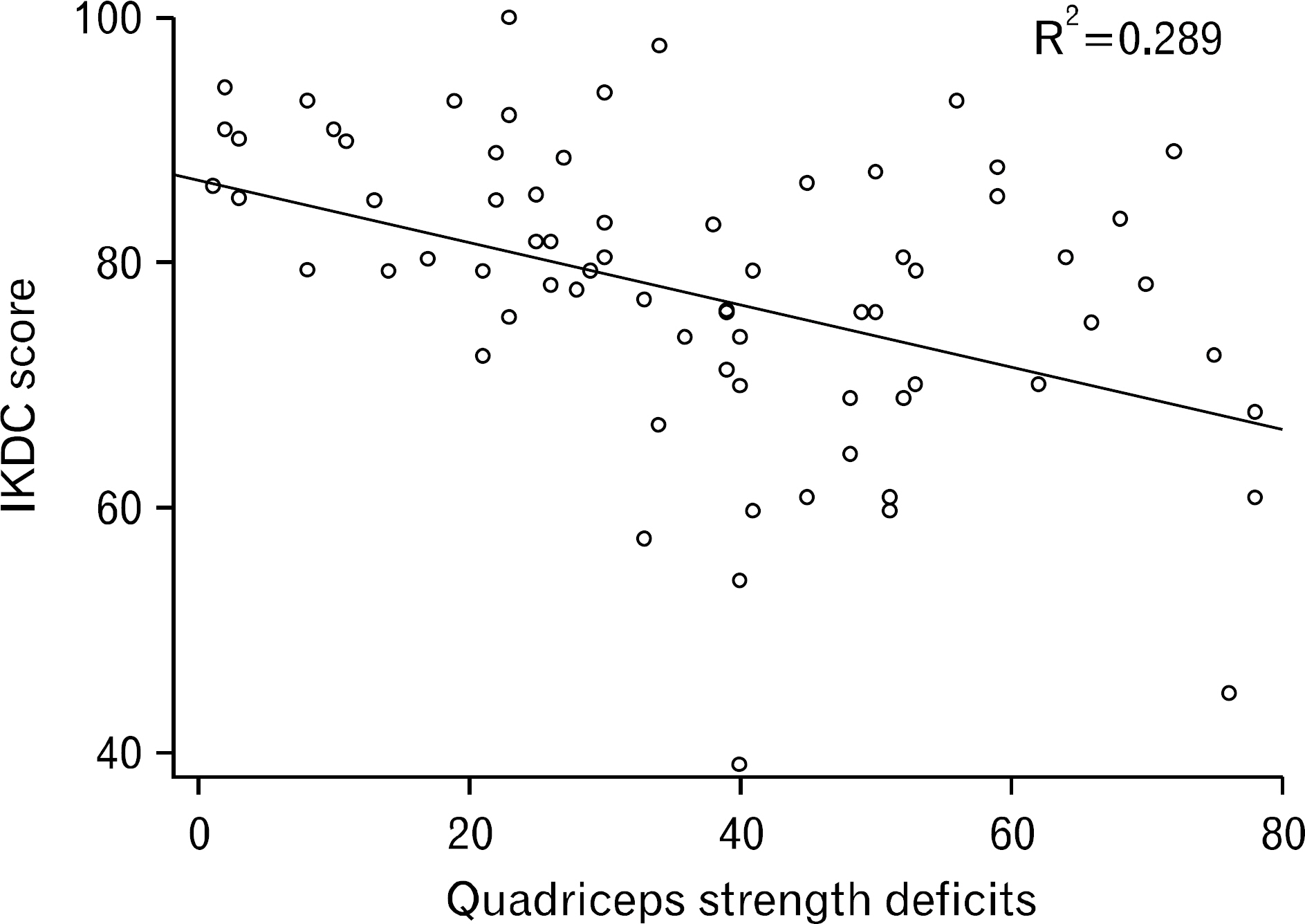Korean J Sports Med.
2013 Jun;31(1):7-12. 10.5763/kjsm.2013.31.1.7.
Effects of Preoperative Quadriceps Strength on the Knee Functional Scores One Year after Anterior Cruciate Ligament Reconstruction
- Affiliations
-
- 1Division of Sports Medicine, Department of Physical and Rehabilitation Medicine, Samsung Medical Center, Sungkyunkwan University School of Medicine, Seoul, Korea. hrmax1@naver.com
- KMID: 1838967
- DOI: http://doi.org/10.5763/kjsm.2013.31.1.7
Abstract
- To identify how influence preoperative predictable factors for knee function after one year of anterior cruciate ligament reconstruction (ACLR). The purpose of this study is to investigate the relationship of preoperative quadriceps strength and post-operative knee function scores (Lysholm score and International Knee Documentation Committee [IKDC] score) after surgery. We extracted seventy-one subjects who underwent hamstring autograft reconstruction to evaluate randomly. Muscle strength deficits were measured with CSMI isokinetic dynamometer. One year after ACLR, we collected these scores from subjects completed. After identification of baseline independent variables between quadriceps muscle strength deficits and both Lysholm score and IKDC score, we examined that how relevant influence in these relationship with these factors by classifying quartile groups. We demonstrated that quadriceps muscles strength and knee function scores were identified as significant correlation. It was compared with quartile outcome in order to analyze that how different result comes out as a degree of deficit. As a result, the only Q1 group who indicated less quadriceps muscle strength deficit (within 23% deficits) effected to knee function scores after one year surgery. The less of quadriceps muscle strength deficit indicated before surgery, the better functional knee score level turns up. Therefore, the result verified that there are significantly positive influences between these relationships after one year of ACLR.
Keyword
MeSH Terms
Figure
Reference
-
References
1. Ardern CL, Webster KE, Taylor NF, Feller JA. Return to the preinjury level of competitive sport after anterior cruciate ligament reconstruction surgery: two-thirds of patients have not returned by 12 months after surgery. Am J Sports Med. 2011; 39:538–43.2. Myklebust G, Bahr R. Return to play guidelines after anterior cruciate ligament surgery. Br J Sports Med. 2005; 39:127–31.
Article3. Smith FW, Rosenlund EA, Aune AK, MacLean JA, Hillis SW. Subjective functional assessments and the return to competitive sport after anterior cruciate ligament reconstruction. Br J Sports Med. 2004; 38:279–84.
Article4. Keays SL, Bullock-Saxton JE, Keays AC, Newcombe PA, Bullock MI. A 6-year follow-up of the effect of graft site on strength, stability, range of motion, function, and joint degeneration after anterior cruciate ligament reconstruction: patellar tendon versus semitendinosus and Gracilis tendon graft. Am J Sports Med. 2007; 35:729–39.5. Keays SL, Bullock-Saxton JE, Newcombe P, Keays AC. The relationship between knee strength and functional stability before and after anterior cruciate ligament reconstruction. J Orthop Res. 2003; 21:231–7.
Article6. de Jong SN, van Caspel DR, van Haeff MJ, Saris DB. Functional assessment and muscle strength before and after reconstruction of chronic anterior cruciate ligament lesions. Arthroscopy. 2007; 23:21–8.e1–3.
Article7. Palmieri-Smith RM, Thomas AC, Wojtys EM. Maximizing quadriceps strength after ACL reconstruction. Clin Sports Med. 2008; 27:405–24.
Article8. Fithian DC, Paxton LW, Goltz DH. Fate of the anterior cruciate ligament-injured knee. Orthop Clin North Am. 2002; 33:621–36.
Article9. Swirtun LR, Renstrom P. Factors affecting outcome after anterior cruciate ligament injury: a prospective study with a six-year follow-up. Scand J Med Sci Sports. 2008; 18:318–24.
Article10. Strasser S, Aharony L, Greenberger D. The patient satisfaction process: moving toward a comprehensive model. Med Care Rev. 1993; 50:219–48.
Article11. Kocher MS, Steadman JR, Briggs K, Zurakowski D, Sterett WI, Hawkins RJ. Determinants of patient satisfaction with outcome after anterior cruciate ligament reconstruction. J Bone Joint Surg Am. 2002; 84:1560–72.
Article12. Tegner Y, Lysholm J. Rating systems in the evaluation of knee ligament injuries. Clin Orthop Relat Res. 1985; 198:43–9.
Article13. Irrgang JJ, Anderson AF, Staubli HU. The new IKDC. In: Proceedings of the Ninth Conference of the European Society of Sports Traumatology, Knee Surgery and Arthroscopy;. 2000. Sep 16–20; London, UK.14. Irrgang JJ, Snyder-Mackler L, Wainner RS, Fu FH, Harner CD. Development of a patient-reported measure of function of the knee. J Bone Joint Surg Am. 1998; 80:1132–45.
Article15. Higgins LD, Taylor MK, Park D, et al. Reliability and validity of the International Knee Documentation Committee (IKDC) subjective knee form. Joint Bone Spine. 2007; 74:594–9.
Article16. Dye SF, Wojtys EM, Arbor A, Fu FH, Fithian DC, Gillquist J. Factors contributing to function of the knee joint after injury or reconstruction of the anterior cruciate ligament. J Bone Joint Surg Am. 1998; 80:1380–93.17. Risberg MA, Holm I, Myklebust G, Engebretsen L. Neuromuscular training versus strength training during first 6 months after anterior cruciate ligament reconstruction: a randomized clinical trial. Phys Ther. 2007; 87:737–50.
Article18. Lautamies R, Harilainen A, Kettunen J, Sandelin J, Kujala UM. Isokinetic quadriceps and hamstring muscle strength and knee function 5 years after anterior cruciate ligament reconstruction: comparison between bone-patellar tendon-bone and hamstring tendon autografts. Knee Surg Sports Traumatol Arthrosc. 2008; 16:1009–16.19. Moisala AS, Jarvela T, Kannus P, Jarvinen M. Muscle strength evaluations after ACL reconstruction. Int J Sports Med. 2007; 28:868–72.
Article20. Sernert N, Kartus J, Kohler K, et al. Analysis of subjective, objective and functional examination tests after anterior cruciate ligament reconstruction. A follow-up of 527 patients. Knee Surg Sports Traumatol Arthrosc. 1999; 7:160–5.21. Eitzen I, Holm I, Risberg MA. Preoperative quadriceps strength is a significant predictor of knee function two years after anterior cruciate ligament reconstruction. Br J Sports Med. 2009; 43:371–6.
Article
- Full Text Links
- Actions
-
Cited
- CITED
-
- Close
- Share
- Similar articles
-
- Knee Muscle Strength after Revision Anterior Cruciate Ligament (ACL) Reconstruction: Comparison Primary ACL Reconstruction
- Neuromuscular electrical stimulation therapy after knee surgery: a systematic review
- Anterior Cruciate Ligament Reconstruction with Achilles Tendon Allograft
- Reconstruction of the Anterior Cruciate Ligament using an Achilles Tendon Autograft: Preliminary Study
- Ligament Reconstruction in Congenital Absence of the Anterior Cruciate Ligament: A Case Report



